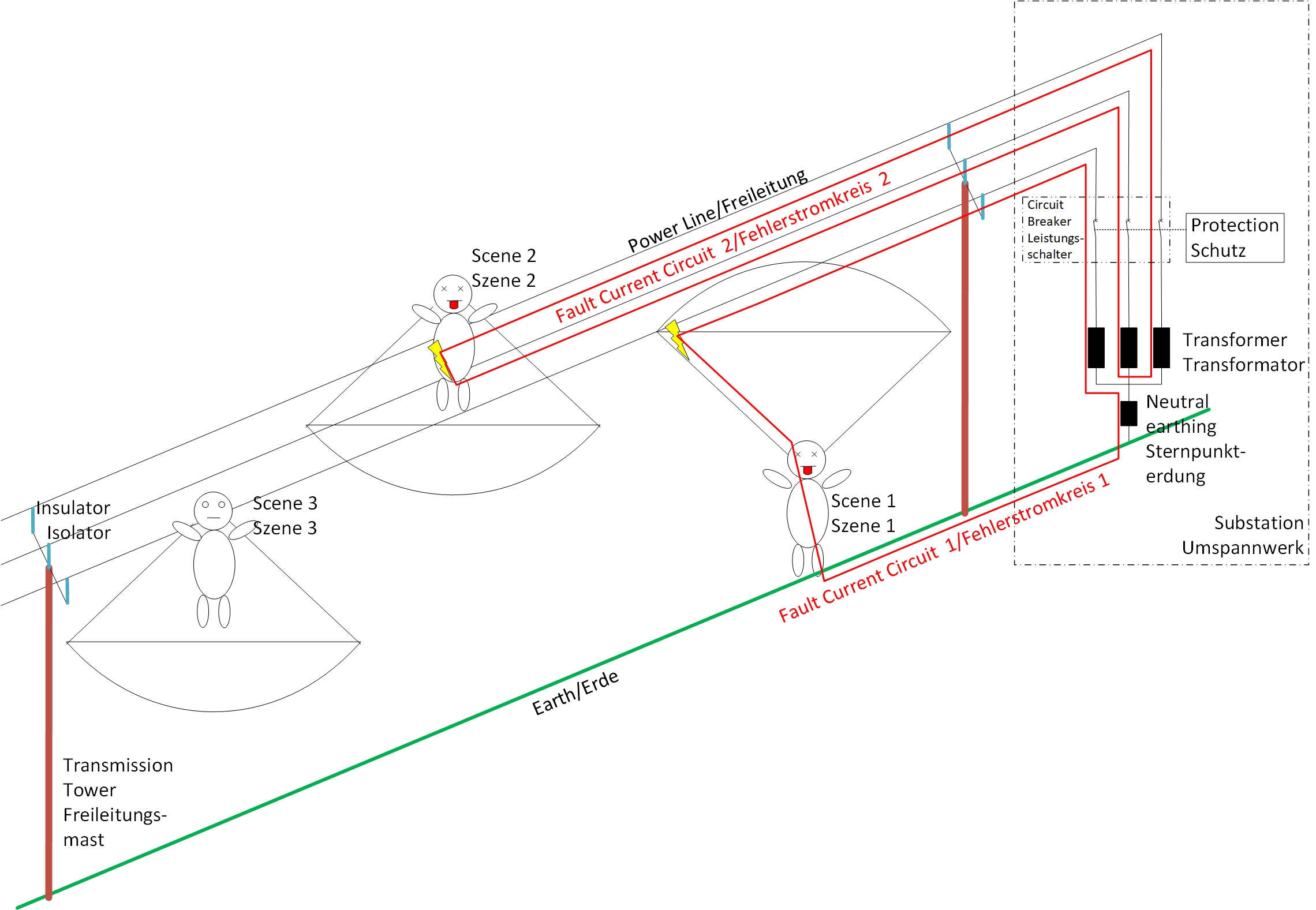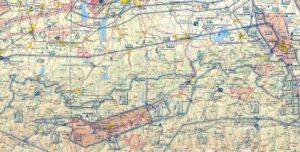Every paraglider should be aware that power lines, compared to other ropes (e.g. material rope way), harbor additional dangers, namely electric shocks. In this article, you will find out why an accident pilot who is in contact with an overhead power line should not be helped immediately and what else needs to be considered in…
Update 23.12.2023: Various corrections
Introduction
As I work in the electricity supplier and was inspired by Lucian’s podcast with Charlie (Podcast in German), I would like to share my knowledge of the dangers overhead power lines pose to paraglider pilots. I have tried to express myself as simply as possible in the following description, even if it is technically not always highly correct. If you want to know more details, please refer to Wikipedia, Google or specialist literature.
There are some ugly examples on YouTube showing that overhead power lines are a real hazard for us paraglider pilots, so I think it’s worth taking a closer look at for every pilot.
I have only described the electrical dangers, I have not considered the other dangers that emanate from power lines in more detail here. Unfortunately, because of our vertical expansion, we paragliders fit exactly into the prey scheme of medium-voltage power lines (10 and 20 kV are common in Germany), so I have mostly focused on this voltage level when presenting various accident scenarios and have described four possible scenarios. Of course, many other scenarios are conceivable that lie somewhere in between, but I think I’ve covered a large part with these four. It should also be noted that at higher voltage levels (110 kV and above) the risk potential is of course much higher.
The three accident scenarios are shown graphically in the figure above (The fourth ist not displayed), but can also be downloaded here for a better representation:
Anyone who struggles with terms such as current and voltage should refer to the following Wikipedia article: Hydraulic Analogy. If all this is still too technical and too complicated for you, you should simply read the summary below.
Limitations
Basically, I can only give general tips and suggestions here, each pilot is of course responsible for himself how he or she behaves in certain cases. The matter is too complex to be able to describe it completely in this article, so I would like to expressly refer to personal responsibility at this point, especially when it comes to one’s own life.
The behavior of the feeding substation in the event of an accident can vary from energy supplier to energy supplier. This depends, among other things, on how the protection is wired and parameterized and how the neutral point is grounded. How the electrical systems are designed in detail by the respective energy suppliers is beyond my knowledge. Therefore, I can only describe the usual behavior in the event of an error at this point.
Furthermore, I have presented the substation in an extremely simplified way, so that even the electrotechnical layman has a chance to understand the facts. But the power line is also available in a wide variety of designs and variants, so I can’t go into every single fact here either.
Terms
For a better understanding, the following definitions of the terms used:
Automatic circuit reclosers (ACR): Particularly nasty function for us paragliders. After the circuit breaker has been switched off after a fault, it automatically switches it on again after a specified time (0.2 to 5 seconds).
Arc flash: An arc flash is the light and heat produced as part of an arc fault, a type of electrical explosion or discharge that results from a connection through air to ground or another voltage phase in an electrical system (source: Wikipedia).
Circuit breaker: With a circuit breaker, operating currents and short circuits can be switched off.
Control: Serves to control and monitor electrical systems.
Electrical voltage: The specified voltages (medium voltage: 10 kV and 20 kV, high voltage: 110 kV, maximum voltage: 220 kV and 380 kV or, depending on the energy supplier, all possible other voltages in between) refer to the conductor voltage, i.e. rope to rope on the power line. Rope to earth is smaller by a factor of 1.73 (root of 3) (5.8 kV, 57 kV, etc.).
Electrical injury: Electrical injury is a physiological reaction caused by electric current passing through the body. Electrical injury is a physiological reaction caused by electric current passing through the body (source: Wikipedia).
Electrical Circuit: An electrical circuit is a system of conductors that forms a closed path.
Fault current: Current caused by a fault in the power line and measured in the protection.
Insulator: Component between power line robe and transmission tower. The electrical voltage can be estimated based on the length of the insulators.
Neutral earthing: Connection of the windings of a transformer to form a connection point. The connection point is usually routed via a coil in medium-voltage networks and directly to earth in high-voltage networks.
Operating current: Current in the power line caused by normal operation (by the consumer).
Overhead line: An overhead line or overhead wire is an electrical cable that is used to transmit electrical energy to electric locomotives, trolleybuses or trams (source: Wikipedia).
Power Line: An electrical conductor consisting of three cables stretched from one pylon to another.
Protection: The protection in the substation or, if applicable, transformer station is intended to differentiate between fault currents and operating currents. In the event of an error, this is switched off via the circuit breaker. There are different types of protection (TOC, distance protection and line differential) that can protect the power line, but they will not be discussed in detail here. To put it simply, if the fault current exceeds the limit value set in the protection, this will trigger the circuit breaker.
Step voltage: “Step voltage” is the voltage between the feet of a person standing near an energized grounded object. It is equal to the difference in voltage, given by the voltage distribution curve, between two points at different distances from the “electrode”. A person could be at risk of injury during a fault simply by standing near the grounding point (source: Wikipedia).
Substation: In the substation, the high voltage (e.g. 110 kV) is transformed into medium voltage (e.g. 10 kV) and distributed.
Transmission tower: A transmission tower, also known as an electricity pylon or simply a pylon in British English and as a hydro tower in Canadian English, is a tall structure, usually a steel lattice tower, used to support an overhead power line (source: Wikipedia).
Transformer: Transforms electrical voltages from one voltage level to another, e.g. 110kV to 10kV.
Accident scenarios
Here are the scenarios I came up with and the possible consequences:
Accident scene 1
In accident scene 1, the wing is in contact with the power line, while the pilot is in contact with the ground. Normally one should assume that the lines, since they are made of plastic, have a very good insulating capacity. But that is not the case (also to my surprise), as can be seen in this video. Unfortunately, you can’t see it in the video, but I assume that this is a medium-voltage power line. The fact that the circuit is closed at all is due to the neutral earthing in the substation. The protection may detect a ground fault but not a short circuit because the current flowing is within the normal operating current range. It can therefore be assumed that the power line is still live. It is therefore urgently advised not to help a pilot who has had an accident immediately, but to keep a good distance, call the emergency number and wait until the rescue services confirm that the voltage (usually from the feeding substation) has been switched off. Only then can rescue measures begin.
The pilot himself can of course try to get himself out of the danger zone as quickly as possible. The pilot in the video makes the mistake and opens the right carabiner, an arc occurs, and the power line breaks at the same time. That was probably his luck, otherwise he might have suffered a fatal electric shock. It would have been better to open the chest strap and move away. Even the power line lying on the ground will not cause the protection to trip, because the current flow will not reach the fault current, which will cause the protection to trip.
One should move out of the danger area as quickly as possible, and in small steps because of the so-called step voltage. The power line must always be considered live until the rescue services give the all-clear.
Since high-voltage power lines usually run at great heights, such an accident is unlikely. Of course, high-voltage power lines can also run close to the ground in special cases.
Accident scene 2
In accident scene 2, the pilot bridges 2 ropes, thus bridging the full phase-to-phase voltage of e.g. 10 kV. The pilot’s death is very likely if there is no full short circuit caused by vibrations in the ropes. In this case, the protection would detect a fault current and open the circuit breaker. If the energy supplier has an automatic circuit reclosers, the circuit breaker will switch on again after a short time, so the pilot is under voltage again. If he somehow survived the first electrocution, he gets hit again.
In the event that the pilot bridges the robes with his body, the protection will most likely not detect a fault and the power line will remain live. As already explained in case 1, rescue measures should not be taken until the rescue workers arrive and have confirmed that there is no voltage.
Since the cables of high-voltage power lines are far apart, it is unlikely that he will bridge them with his body. But it would be conceivable that an arc takes place.
Accident scene 3
Even if the pilot gets caught in the grounding cable of a high-voltage power line, as in this video, the principle is similar to getting caught on a ladder rope. As long as you don’t hit a second rope or ground, or arc flash, you have nothing to worry about. If possible, you should secure yourself with a sling, keep the greatest possible distance to other ropes, masts and earth and call the emergency number. You should not try to rescue yourself and ask other people to keep their distance.
Basically, the higher the voltage, the greater the distances that can be bridged by arcs.
Accident scene 4
It gets particularly ugly when it comes into contact with the Deutsche Bahn overhead line, as the track is used as a return conductor (Accident scene 4 is not in the representation). If the wing is in contact with the overhead line and the pilot comes to rest on the track, the full 15 kV that is usual there comes into play. To make matters worse, the protection may not detect the error, since it looks like a normal operating current due to the high contact resistance. The case is similar to accident scene 2, the death of the pilot is likely if the insulating capacity of the suspension lines is not sufficiently high. I don’t want to go into detail here about the railway-specific protection and automatic restart.
Summary
If the above description, despite the great simplification, is still too complicated, the following brief summary is recommended:
- Power lines are fundamentally designed for security of supply and not for personal safety. From this follows the great danger potential for us paraglider pilots
- As a rule, the protection in the substations does not recognize the pilot in the power line, so the power line remains live in the event of a fall
- Persons should keep their distance from pilots involved in an accident until the rescue services have confirmed that the power line has no voltage
- If the pilot only touches a rope: secure against falling, call for help, ask other people to keep their distance and wait. Avoid contact or come to close (because of arcs) to other ropes, mast and ground
- If a power line has fallen, you should immediately move away from the danger point in small steps. This also applies if the pilot has contact with the power line, as in accident scene 1





Thanks a lot!